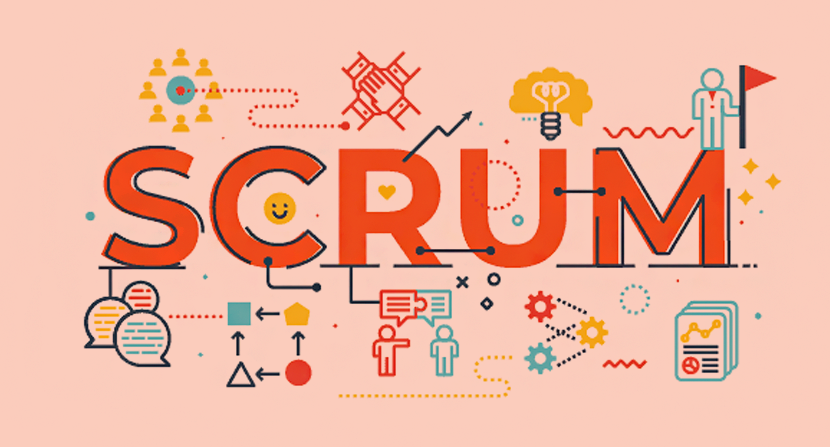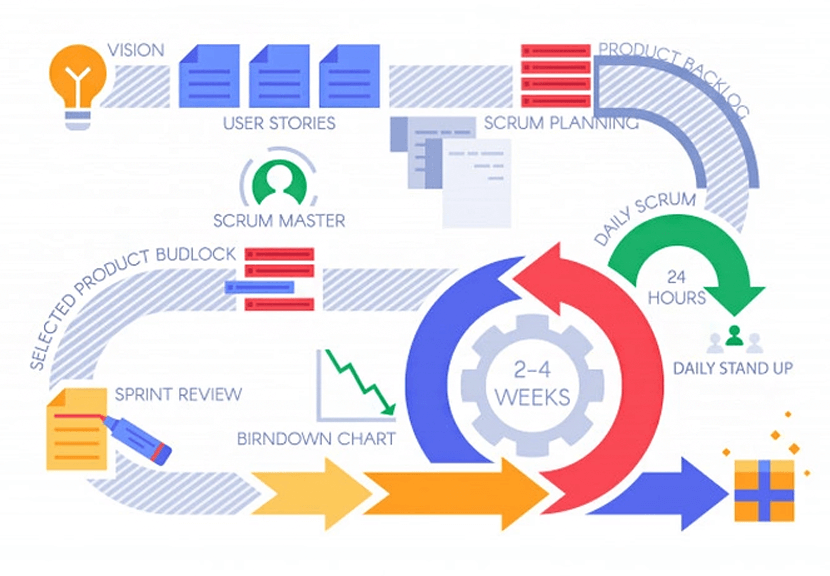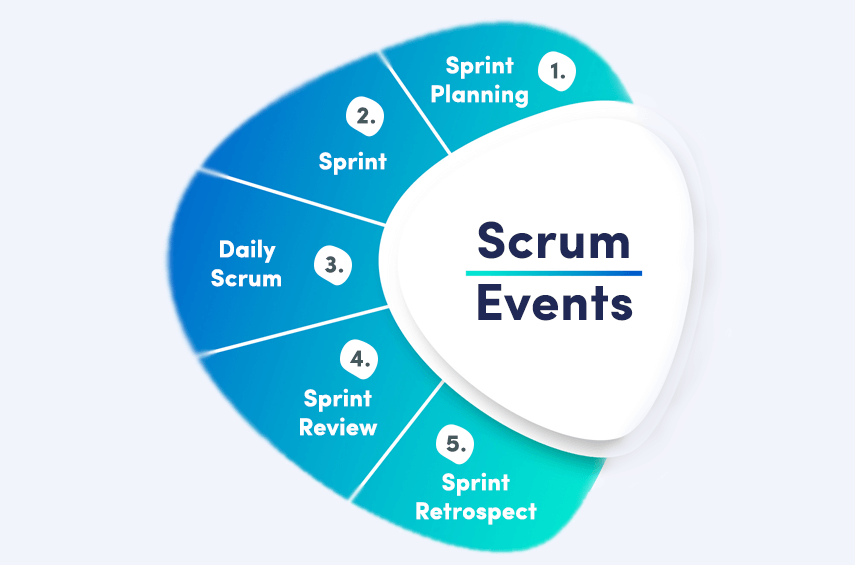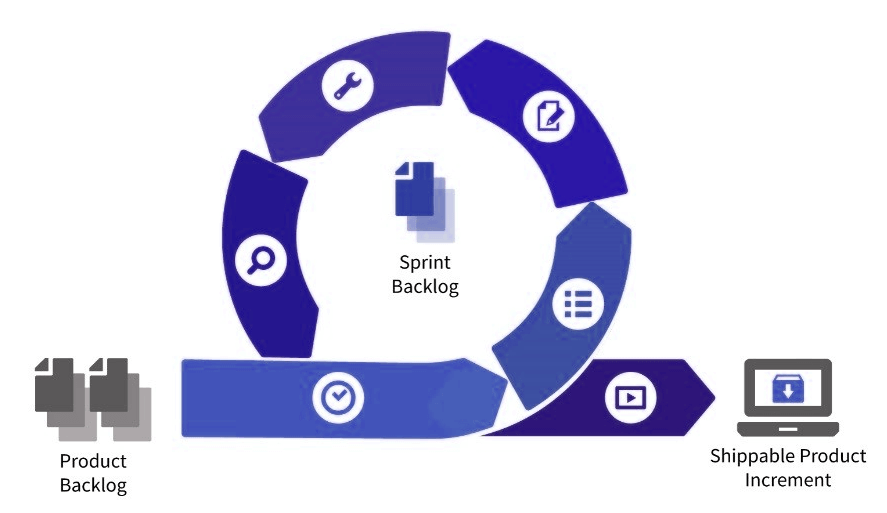By Mrugesh Panchal,

Introduction
Scrum is a sports term that is used to describe a new-age management concept. Scrum refers to the team huddle in a rugby game every time there is a foul or if the ball has left the field. As a general practice, rugby players use the team huddle as an opportunity to define their strategy for the upcoming minutes of the game. As you can imagine, in every Scrum, the strategy rapidly evolves according to the match’s unique challenges and the mistakes the team has made in the past few minutes. This concept is the basic meaning of Scrum and defines what Scrum is.
Like rugby, in software development, the team is up against a rapidly changing business environment, evolving client requirements, and complex adaptive problems. Usually, Scrum is defined as the evolution of agile project management. Scrum is a flexible methodology based on empiricism. Scrum enables a team to learn through their experience and make an organized effort to deliver a software solution while simultaneously analyzing their past results (good and bad, both) for continuous improvement.
What is Scrum?
In Agile, a stand-up meeting (or “standing meeting”) is a short meeting between a team that is held on foot. The goal is to go over important tasks that have been finished, are in progress, or are about to be started.
It is also known as daily stand-up or daily Kanban to teams practicing the Kanban method due to the recurring cadence of the meeting.
Initially, the daily stand-up meetings originated in Scrum but were quickly adopted by teams using various frameworks and methods related to Agile.

The Scrum framework’s beauty is that it accepts that the team does not know everything and allows for evolution through experience at the beginning of the project. Scrum helps teams adapt to changing conditions and user requirements with constant re-prioritization and short release cycles that help the team learn and improve on the job.
The Scrum methodology is useful for cross-functional teams working to achieve product development goals. Scrum works well in a scenario where the team can split the work into several sets of 2-4 week iterations.
Check out the best-in-class enterprise tool for Scrum teams right here. QuickScrum develops all its applications with your team in mind. With features such as product backlog detailing, a one-view project dashboard, sprint planning, and the Kanban board, you can implement Scrum best practices and bring agility to your project completion.
Do you want to know more about Scrum?
Scrum vs. Agile
A lot of people confuse Scrum with Agile management. In reality, agile leadership is an attitude or an ethos that every team strives to achieve, while Scrum is an action-oriented framework for teams to work with.
In other words, teams that wish to achieve the ‘agile mindset’ can begin by implementing Scrum methodology in their work. When a team consistently delivers value to its customers through the Scrum methodology, they end up building agile management principles into their day-to-day work and communication.
Scrum urges teams to focus on core principles such as transparency, clarity of communication, and perseverance to improve. Apart from that, the Scrum framework is flexible and can be adapted to your team’s unique needs. But, as long as your team stays focused on the core principles of Scrum, they will eventually build an agile management thought process into every job they do. This is the reason why this framework is also referred to as the agile scrum methodology.

Scrum Events
The Scrum framework prescribes a set of events that help create the lifecycle of the project. These events are defined to minimize duplicity of efforts and the need for meetings during the project. All events in the Scrum methodology are time-bound and well-defined.

Here’s a look at the different events in a scrum:
1. Sprint: A Sprint is defined as a duration of one month or less within which a team can achieve a tangible goal or produce a deliverable. A deliverable could be a shippable product or product increment. Sprints are
-
-
-
- Time boxed events: The start date and end date of the Sprint are fixed beforehand. The duration of a sprint cannot be shortened or lengthened.
- Consecutive – As soon as one Sprint is completed, a new sprint immediately follows it.
- A basic unit of the work for a Scrum team.
-
-
2. Sprint Planning: Sprint planning is an event wherein the deliverables to be focused on are decided. These deliverables are taken from the product backlog. The identified items from the product backlog form the Sprint backlog. Once the Sprint backlog is determined, then no more items can be added. Sprint planning usually has two parts:
-
-
-
- The product owner and his team decide which items from the product backlog will be focused on in the first part.
- In the second part, the team identifies the tasks to be completed to deliver the specified product backlog items. This part of Sprint planning defines the scope of the Sprint.
-
-
3. Daily Scrum: The daily Scrum meeting is a brief discussion wherein the team coordinates its activities for the following day. The Daily Scrum is not a status report meeting or a problem-solving conversation. The purpose of the daily Scrum is coordination among the team and sharing updates.
4. Sprint Review: The Sprint Review is a meeting among the team members and the stakeholders to review the Sprint results. This discussion is purposed towards getting feedback about the work done. Any inputs received from the stakeholders is placed into the product backlog for future consideration.
5. Sprint Retrospective: This is an internal meeting among the product owner and team members to define the previous Sprint learning. Eventually, any adjustments to be made or changes that are needed are included in the next Sprint‘s Sprint backlog.
At QuickScrum, we develop high-quality tools that aid project managers every step of the way. With Scrum, you can prioritize the product backlog, maximize your Sprint’s business value, and monitor team productivity like never before using our unique timesheet. Find out more now!
Who’s on The Scrum Team?
The people on a Scrum team can be broadly categorized into three roles. These roles share the same objectives: to maintain, if not improve, delivery quality and overcome any obstacles in their journey to project completion.
1. Product Owner
The product owner effectively represents the stakeholders and final users of the product being developed. The product owner leads the team, provides direction, and resolves conflicts within the group. The product backlog is the primary responsibility of the product owner.
2. Scrum Master
The Scrum Master is responsible for ensuring that the team understands the Scrum concept and follows Scrum practices throughout the project. This role’s objective is to have an agile management expert who can advise and guide the team whenever needed.
3. Team
A team is a group of professionals with the technical knowledge needed to accomplish the project. The development team members complete the required tasks or stories they define at the beginning of a sprint.
Scrum Artifacts
Scrum artifacts are the three tools that define what is “done” and what is “pending. These three sets of information are revisited many times during the project. They help define and revise the work to be done by the team in Scrum. QuickScrum offers Scrum solutions that allow a product owner and Scrum master to closely monitor Scrum artifacts and a sprint’s progress with features like Scrum Board, Release Planning, and Sprint Planning. Find out more. Here’s a look at the Scrum Artifacts in detail:
- Product Backlog: This is the list of work that needs to get done to accomplish a project.
- Sprint Backlog: This list of selected items from a product backlog is what Sprint is focused on. Sprint backlogs can evolve during a sprint.
- Increment: This is also known as the goal of a sprint. An increment is a milestone a product owner hopes to achieve at the end of a sprint.

The Benefits of Scrum
Scrum is a framework that helps simplify the development process for a project. The flexibility and simplicity offered by the Scrum approach help industries define efficient development processes. It also allows room for adjustments and changes as needed.
Scrum offers project managers the opportunity to clearly define the roles and events of the project. This introduces clarity and transparency in the development process. This is especially beneficial for complex projects, as the whole process can be broken up into small milestones achieved by sprints.
Quick releases and successful sprints do wonders to keep a team motivated. It shows progress and helps keep the project on track at all times.
Adopting the Scrum methodology may be a cultural shift, and the whole process may take time to master. But the right technology can make all the difference. QuickScrum creates smart solutions and tools that can help your team implement Scrum and Agile best practices.
Conclusion
Scrum has been a successful tool for efficient and transparent development processes for many decades. The initial phases of implementing Scrum may be uncomfortable for a development team, but the long-term benefits outweigh this.
